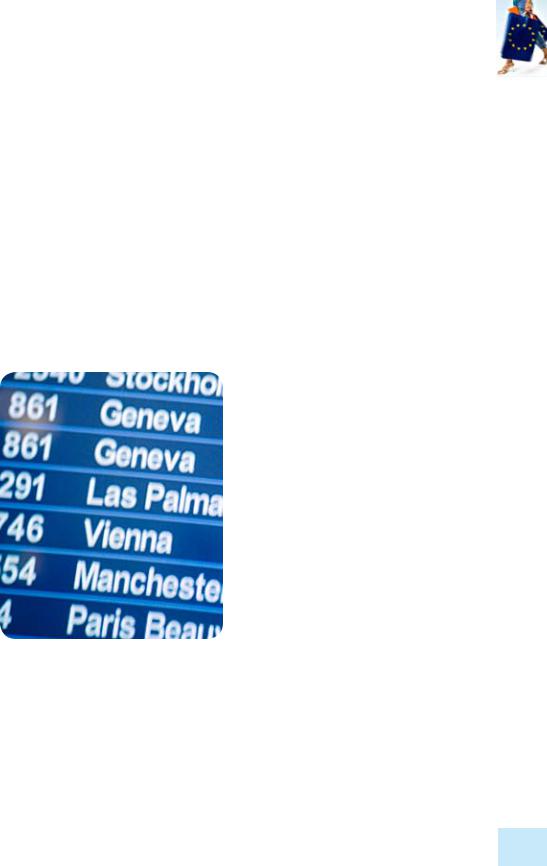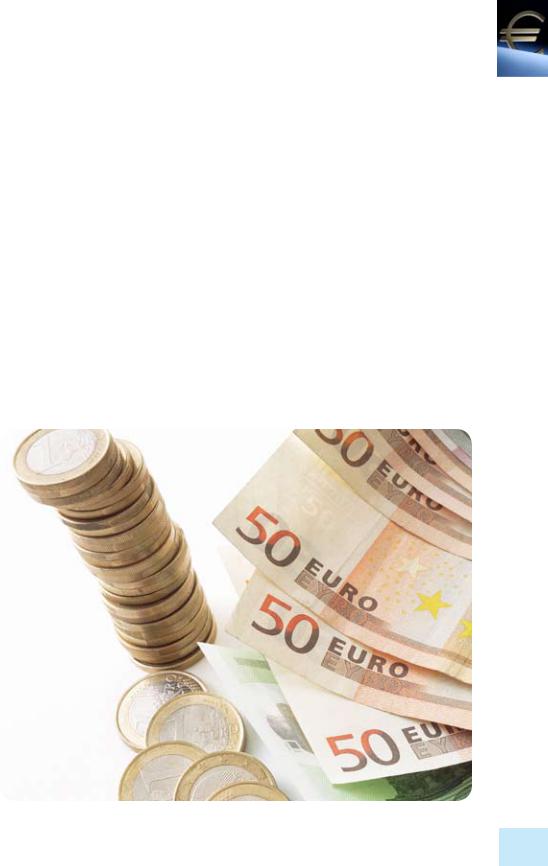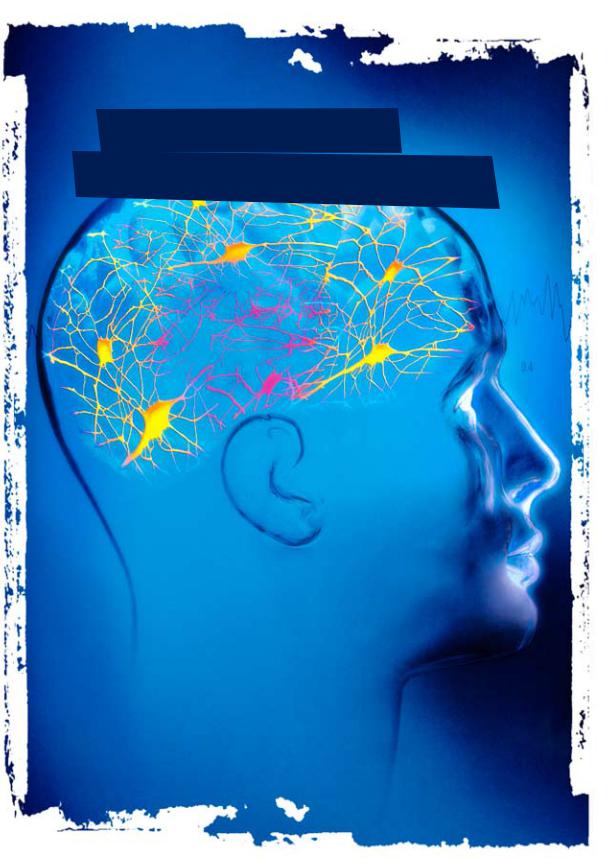
01_EU_overview
.pdf
• The single market is one of the European Union’s greatest |
|
achievements. Restrictions between member countries on trade |
lessons12 |
• The single market has not yet become a single economic area. |
|
and free competition have gradually been eliminated, |
|
with the result that standards of living have increased. |
|
Some sectors of the economy (public services) are still subject |
in |
to national laws. |
Europe |
• The individual EU countries still largely have the responsibility |
|
for taxation and social welfare. |
|
• The single market is supported by a number of related policies put |
|
in place by the EU over the years. They help ensure that market liberalisa- |
|
tion benefits as many businesses and consumers as possible. |
|
I. Achieving the 1993 objective
a. The limits of the common market
The 1957 Treaty establishing the European Economic Community made it possible to abolish customs barriers within the Community and establish a common customs tariff to be applied to goods from nonEEC countries. This objective was achieved on 1 July 1968.
However, customs duties are only one aspect of protectionist barriers to cross-border trade. In the 1970s, other trade barriers hampered the complete achievement of the common market. Technical norms, health and safety standards, national regulations on the right to practise certain professions and exchange controls all restricted the free movement of people, goods and capital.
b. The 1993 objective
In June 1985, the Commission, under its then President, Jacques Delors, published a White Paper seeking to abolish, within seven years, all physical, technical and tax-related barriers to free movement within the Community. The aim was to stimulate industrial and commercial expansion within a large, unified economic area on a scale with the American market.
The enabling instrument for the single market was the Single European Act, which came into force in July 1987. Its provisions included:
•extending the powers of the Community in some policy areas (social policy, research, environment);
•gradually establishing the single market over a period up to the end of 1992, by means of a vast legislative programme involving the adoption of hundreds of directives and regulations;
•making more frequent use of majority voting in the Council of Ministers.
II. How the single market looks today
a. Physical barriers
All border controls within the EU on goods have been abolished, together with customs controls on people. Random spot checks by police (part of the fight against crime and drugs) still take place when necessary.
29

The Schengen Agreement, which was signed by a first group of EU countries in 1985 and later extended to others (although Ireland and the United Kingdom do not participate), governs police cooperation and a common asylum and immigration policy, so as to make it possible to completely abolish checks on persons at the EU’s internal borders (see Lesson 10: ‘Freedom, security and justice’). The countries which have joined since 2004 are gradually coming into line with the rules of the Schengen area.
b. Technical barriers
For the majority of products, EU countries have adopted the principle of mutual recognition of national rules. Any product legally manufactured and sold in one member state must be allowed to be placed on the market in all others.
It has been possible to liberalise the services sector thanks to mutual recognition or coordination of national rules concerning access to or practice of certain professions (law, medicine, tourism, banking, insurance, etc.). Nevertheless, freedom of movement for persons is far from complete. Obstacles still hinder people from moving to another EU country or doing certain types of work there.
Action has been taken to improve worker mobility, and particularly to ensure that educational diplomas and job qualifications (for plumbers, carpenters, etc.) obtained in one EU country are recognised in all the others.
The opening of national services markets has brought down the price of national telephone calls to a fraction of what they were 10 years ago. Helped by new technology, the internet is being increasingly used for telephone calls. Competitive pressure has led to significant falls in the price of budget airfares in Europe.
c. Tax barriers
Tax barriers have been reduced through the partial alignment of national VAT rates. Taxation of investment income was the subject of an agreement between the member states
and some other countries (including Switzerland) which came into force in July 2005.
d. Public contracts
Regardless of whether they are awarded by national, regional or local authorities, public contracts are now open to bidders from anywhere in the EU as a result of directives covering services, supplies and works in many sectors, including water, energy and telecommunications.
III. Work in progress
a. Financial services
The EU’s action plan to create an integrated market for financial services by 2005 has been completed. This cuts the cost of borrowing for businesses and consumers, and will offer savers a wider range of investment products — savings plans and pension schemes — which they will be able to obtain from the European provider of their choice. Bank charges for cross-border payments have been reduced.
b. Administrative and technical barriers to free movement
EU countries are often still reluctant to accept each other’s standards and norms or, on occasion, to recognise the equivalence of professional qualifications. The fragmented nature of national tax systems also hinders market integration and efficiency.
c. Piracy and counterfeiting
Protection is required to prevent piracy and counterfeiting of EU products. The European Commission estimates that these crimes cost the EU thousands of jobs each year. This is why the Commission and national governments are working on extending copyright and patent protection.
IV. Policies underpinning the single market
a. Transport
The EU’s activities have targeted mainly the freedom to provide services in land transport, particularly free access to the international
30

transport market and the admission of nonresident transport firms into the national transport market of member countries. Decisions have been taken to harmonise the conditions of competition in the road transport sector, particularly worker qualifications and market access, the freedom to establish a business and provide services, driving times and road safety.
The common air transport policy has to respond to the effects of worldwide competition. The skies over Europe are being liberalised in stages, with the result that there is greater scope for capacity-sharing between major airlines, reciprocal market access and the freedom to set fares. This goes hand in hand with safeguard clauses so as to take account of airlines’ public service responsibilities and zoning requirements.
© Strauss/Curtis/Van Parys Media
Increased competition has driven airfares down and made travel easier.
Shipping — whether carried out by European companies or by vessels flying the flag of non-EU countries — is subject to EU competition rules. These rules are intended to combat unfair pricing practices (flags of convenience) and also to address the serious difficulties facing the shipbuilding industry in Europe.
b. Competition
The EU’s robust competition policy dates from the Treaty of Rome. It is the vital corollary to the rules on free trade within the European single market. This policy is implemented by the European Commission which, together with the Court of Justice, is responsible for ensuring that it is respected.
The reason for this policy is to prevent any agreement between businesses, any aid from public authorities or any unfair monopoly from distorting free competition within the single market.
Any agreement falling under the Treaty rules must be notified to the European Commission by the companies or bodies concerned. The Commission may impose a fine directly on any companies which break its competition rules or fail to make the required notification.
In the event of illegal public aid, or failure to notify such aid, the Commission may demand that it be paid back by the recipient. Any merger or takeover that could lead to a company having a dominant position in a particular sector must be notified to the Commission.
c. Consumer policy
The EU’s consumer policy permits its citizens to shop in confidence in any member country. All consumers benefit from the same high level of protection. The products you buy and the food you eat are tested and checked to make sure they are as safe as can be. The EU acts to make sure you are not cheated by rogue traders and are not the victim of false or misleading advertising. Your rights are protected and you have access to redress wherever you are in the EU and whether you buy your goods in a shop, by mail-order or via the telephone and internet.
Europe in 12 lessons
31

7. Economic and monetary union (EMU) and the euro

• The euro is the single currency of the European Union. Twelve of the then |
|
|
15 countries adopted it for non-cash transactions from 1999 and for all |
lessons |
|
payments in 2002 when euro notes and coins were issued. |
||
|
||
• Three countries (Denmark, Sweden and the United Kingdom) did not |
12 |
|
participate in this monetary union. |
||
|
in |
|
• The new member countries are getting ready to enter the euro area as |
Europe |
|
soon as they fulfil the necessary criteria. |
||
|
||
• In parallel with the objective of monetary stability, which is the responsi- |
|
|
bility of the European Central Bank, the member states are committed to |
|
|
higher growth and economic convergence. |
|
I. The history of monetary cooperation
a. The European monetary system (EMS)
In 1971, the United States decided to abolish the fixed link between the dollar and the official price of gold, which had ensured global monetary stability after World War Two. This put an end to the system of fixed exchange rates. With a view to setting up their own monetary union, EU countries decided to prevent exchange fluctuations of more than 2.25% between the European currencies by means of concerted intervention on currency markets.
This led to the creation of the European monetary system (EMS) which came into operation in March 1979. It had three main features:
•a reference currency called the ecu: this was a ‘basket’ made up of the currencies of all the member states;
•an exchange rate mechanism: each currency had an exchange rate linked to the ecu; bilateral exchange rates were allowed to fluctuate within a band of 2.25%;
•a credit mechanism: each country transferred 20% of its currency and gold reserves to a joint fund.
b. From the EMS to EMU
The EMS had a chequered history. Following the reunification of Germany and renewed currency pressures within Europe, the Italian lira and pound sterling left the EMS in 1992. In August 1993, the EMS countries decided to temporarily widen the bands to 15%. Meanwhile, to prevent wide currency fluctuations among EU currencies and to eliminate competitive devaluations, EU governments had decided to relaunch the drive to full monetary union and to introduce a single currency.
At the European Council in Madrid in June 1989, EU leaders adopted a three-stage plan for economic and monetary union. This plan became part of the Maastricht Treaty on European Union adopted by the European Council in December 1991.
II. Economic and Monetary
Union (EMU)
a. The three stages
The first stage, which began on 1 July 1990, involved:
• completely free movement of capital within the EU (abolition of exchange controls);
• increasing the amount of resources devoted to removing inequalities between European regions (structural funds);
33

© Janez Skok/Corbis
Ljubljana’s market traders swapped the Slovenian tolar for the euro on 1 January 2007.
• economic convergence, through multilateral surveillance of member states’ economic policies.
The second stage began on 1 January 1994. It provided for :
•establishing the European Monetary Institute (EMI) in Frankfurt. The EMI was made up of the governors of the central banks of the EU countries;
•independence of national centra banks;
•rules to curb national budget deficits.
The third stage was the birth of the euro. On 1 January 1999, 11 countries adopted the euro, which thus became the common currency of Austria, Belgium, Finland, France, Germany, Ireland, Italy, Luxembourg, the Netherlands, Portugal and Spain. (Greece joined them on 1 January 2001). From this point onwards, the European Central Bank took over from the EMI and became responsible for monetary policy, which is defined and implemented in euros.
Euro notes and coins were issued on 1 January 2002 in these 12 euro area countries. National currencies were withdrawn from circulation two months later. Since then, only the euro has been legal tender for all cash and bank transactions in the euro area countries, which represent more than two thirds of the EU population.
b. The convergence criteria
Each EU country must meet the five convergence criteria in order to go to the third stage. They are:
•price stability: the rate of inflation may not exceed the average rates of inflation of the three member states with the lowest inflation by more than 1.5%;
•interest rates: long-term interest rates may not vary by more than 2% in relation to the average interest rates of the three member states with the lowest interest rates;
•deficits: national budget deficits must be below 3% of GDP;
34

•public debt: this may not exceed 60% of GDP;
•exchange rate stability: exchange rates must have remained within the authorised margin of fluctuation for the previous two years.
c. The Stability and Growth Pact
In June 1997, the European Council adopted a Stability and Growth Pact. This was a permanent commitment to budgetary stability, and made it possible for penalties to be imposed on any country in the euro area whose budget deficit exceeded 3%. The Pact was subsequently judged to be too strict and was reformed in March 2005.
d. The Eurogroup
The Eurogroup is the informal body where the finance ministers of the euro area countries meet. The aim of these meetings is to ensure better coordination of economic policies, monitor the budgetary and financial policies of the euro area countries and rep-
resent the euro in international monetary forums.
e. The new member states and EMU
New EU members are all due to adopt the euro, when they are able to meet the criteria. Slovenia was the first of countries from the 2004-enlargment to do so and joined the euro area on 1 January 2007.
Europe in 12 lessons
© Creativ Studio Heinem/Van Parys Media
The euro: the common currency for over 310 million people in the EU.
35

8. Towards a knowledge-based society

Priority on growth and jobs |
lessons |
• The Union intends to respond to globalisation by making the Europe |
|
an economy more competitive (liberalisation of telecommunications, |
|
services and energy). |
in 12 |
• The Union is supporting the reform programmes of member countries |
|
by making it easier to exchange ‘best practice’. |
Europe |
• It seeks to match the need for growth and competitiveness with |
|
the goals of social cohesion and sustainable development which are |
|
at the heart of the European model. |
|
• The EU Structural Funds will spend more on training, innovation |
|
and research, in the 2007–13 budget period. |
|
At the beginning of the 1990s, two great changes began transforming economies and daily life throughout the world, including Europe. One was the emergence of a globalised economy as economies everywhere became increasingly interdependent.
The other was the technological revolution, including the internet and new information and communication technologies.
© IMAGEMORE Co, Ltd/Getty Images
Europeans have to be equipped for today’s job market.
37

© Javier Larrea/Van Parys Media
Tomorrow’s pensioners need social security which must be prepared today.
I. The Lisbon Process
a. Objectives
By the year 2000, EU leaders were well aware that the European economy needed thorough modernisation in order to compete with the United States and other major world players. Meeting in Lisbon in March that year, the European Council set the EU a new and ambitious goal: to become, by 2010, ‘the most competitive and dynamic knowledge-based economy in the world, capable of sustainable growth with more and better jobs and greater social cohesion’.
b. The strategy
The European Council also agreed on a detailed strategy for achieving this goal. The ‘Lisbon strategy’ covers a whole range of areas, such as scientific research, education, vocational training, internet access and online business. It also covers reform of Europe’s social security systems. These systems are one of Europe’s great assets, as they enable our societies to embrace necessary
structural and social changes without excessive pain. However, they must be modernised so as to make them sustainable and so that their benefits can be enjoyed by future generations.
Every spring, the European Council meets to review progress in implementing the Lisbon strategy.
II. Closer focus
on growth and jobs
The European Council in spring 2006 did not attempt to hide the fact that, six years after its launch, the results of the Lisbon process have been mixed. As a result, it decided to address the problem of continuing high unemployment in many EU countries and refocus the EU’s priorities on growth and jobs. If it is to make its economies more productive and increase social cohesion, Europe must continue to concentrate its efforts mainly on raising economic performance, innovation and improving its people’s skills.
38
